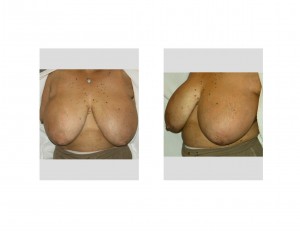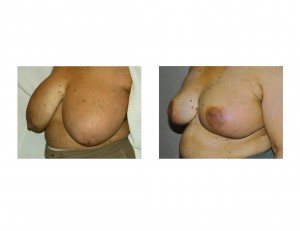Background: Breast reduction is one of the most commonly performed plastic surgery procedures of the body. Because it not only reduces the size of the breast but also reshapes it, every breast reduction is a breast lift also. Because a lift is involved, the nipple must be moved into a better centered positioned on the reshaped breast mound.
While the nipple makes up a very small percent of the total breast, it receives an inordinately greater amount of aesthetic significance. This is acknowledged in the breast reduction operation as most ways of doing this operation is based on keeping the nipple attached and alive to the underlying breast tissue. In very large breast reductions, the nipple will be at some increased risk of survival if kept attached.

In discussing choices of a more significant reduction in size or keeping the feeling and color in the nipples, she preferred the method that would give a smaller breast size. She opted for breast reduction with free nipple grafting. In this method, the nipple is removed initially and put back at the end of the operation as a full-thickness skin graft. This allows virtually any size reduction to be done but at the expense of loss of nipple feeling. In patients with more skin pigment, particularly African-Americans, there would be some changes in the color of the nipple and areola as well.


Because of her found breast tumor in the pathology specimen, she was recommended by the hospital’s tumor board to receive radiation therapy as a precaution. Because of healing, I advised that this should not start until four months after her surgery.
Case Highlights:
1) Surgical reduction of large breasts must take into account the balance of nipple survival and how much breast tissue can be removed.
2) The greatest amount of breast reduction can be achieved with a free nipple grafting technique.
3) Free nipple grafts, like full-thickness skin grafts, will not have feeling afterwards, will have a flattened nipple and will usually undergo some pigment changes of the areolas.
Dr. Barry Eppley
Indianapolis Indiana



